Don't wanna be here? Send us removal request.
Text
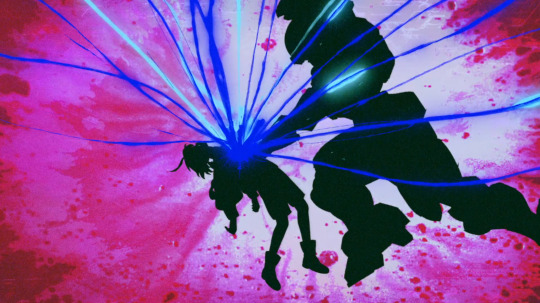

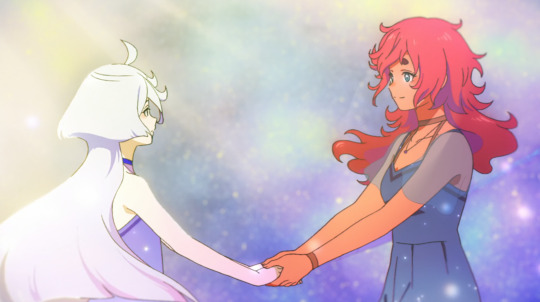



ikuhara references in g-witch's second ending
#has someone done this yet#the ericht/momoka implications of this im tearing my hair out#g witch#revolutionary girl utena#mawaru penguindrum#adolescence of utena#yuri kuma araki
797 notes
·
View notes
Photo
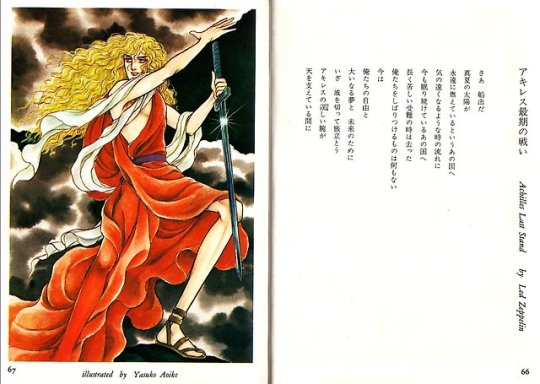
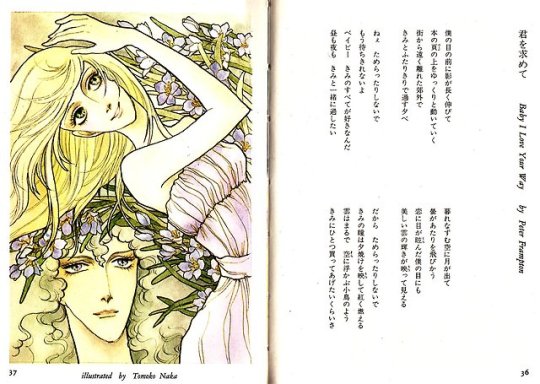

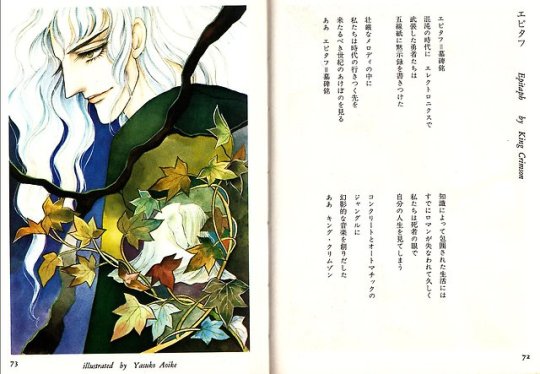
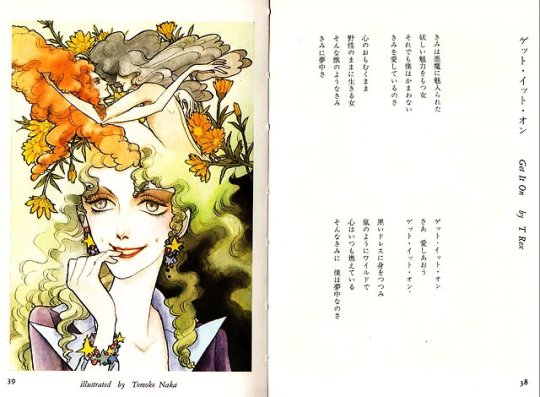
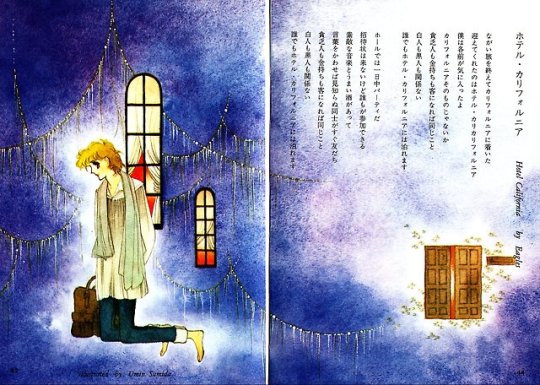
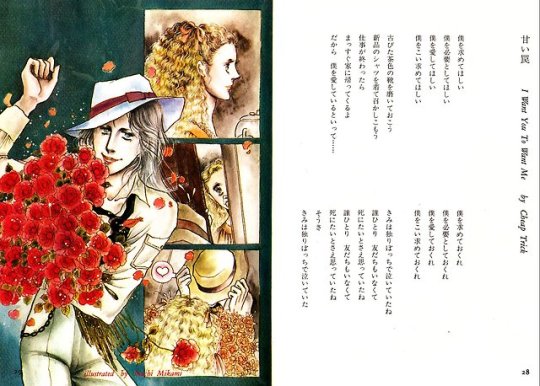
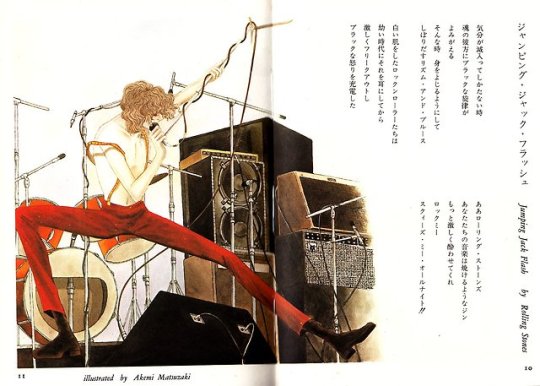
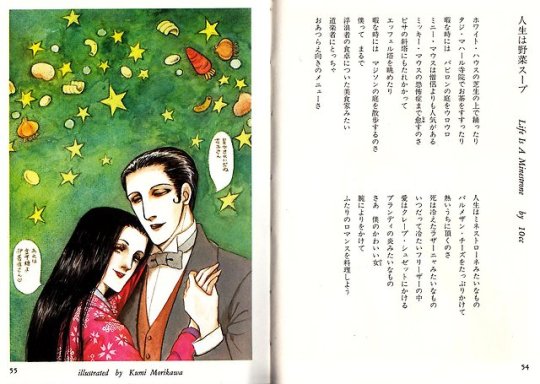
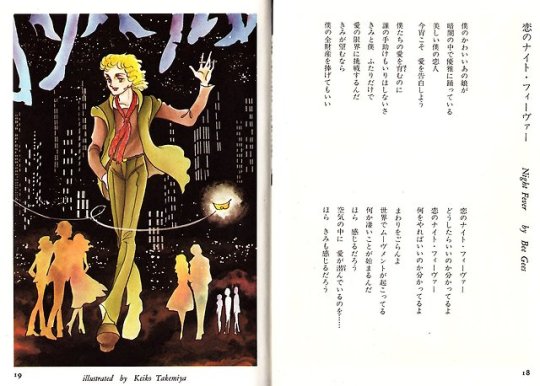
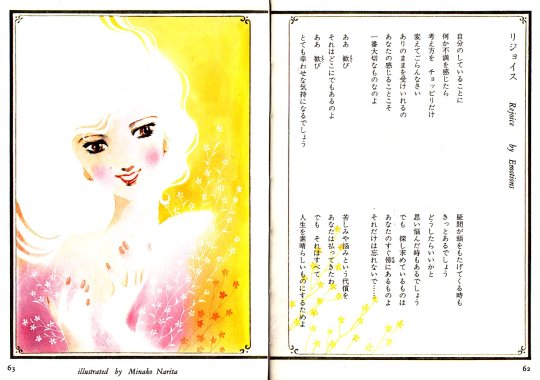
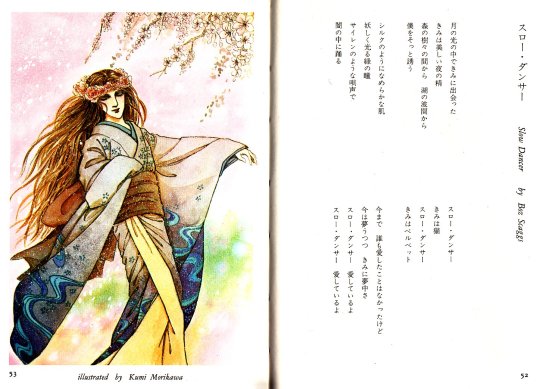
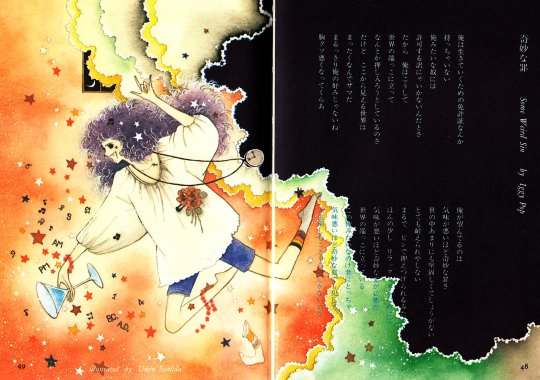
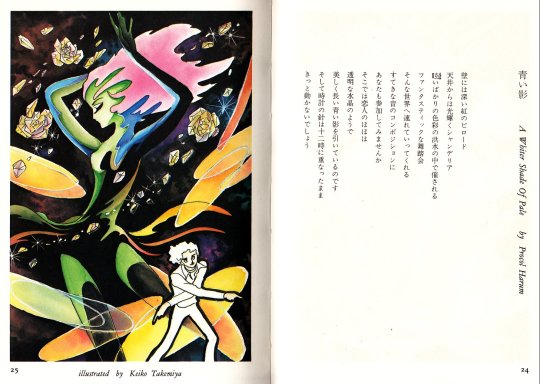

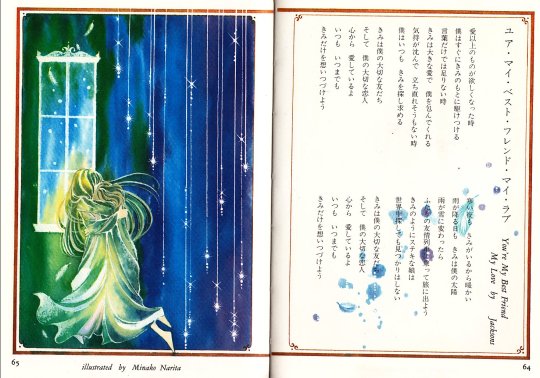
A close friend showed me something I can’t believe I didn’t know about sooner: a shoujo artist fanzine from 1979 illustrating rock songs. Some are more straightforward representations of the artists behind the music, some are interpretations of the lyrics, etc. You can see what song is being represented on the right - everything from Led Zeppelin to Bee Gees (!) to King Crimson to Procol Harum…..isn’t this a treat!!! I have got to locate a copy and buy it!!
737 notes
·
View notes
Text
Natsu no Guuwa by Yamagishi Ryouko (1976)

I'll spare you the long and winded road that got me to Yamagishi Ryouko's Tennin Karakusa (天人唐草) one shot collection... I was supposed to find the bunkoban edition of it, but because I did my research half-assedly, I got the scans from the 1980 collection with the same title. I was bummed that I didn't get the one shot I was looking for (which was 狐女 (Kitsunejo-Fox Lady, 1981) btw), and was skimming through the one shots in the 1980 book in mild disappointment. The last page of one of the stories caught my eye, because of the text taking up the bottom of the page and my brain going "Huh? Isn't that Hiroshima Peace Memorial?". When I read the first line of what's written on that page, I almost fell off my chair. I KNEW what it was. It was a poem by the great Turkish poet Nazım Hikmet, Hiroshima Child (Kız Çocu��u, 死んだ女の子, 1956).
Now, I had to read this one shot. Natsu no Guuwa (夏の寓話 - Summer Fable) was first published in the 1976 August issue of Seventeen magazine, and later compiled in a bunch of books I'm too lazy to list here. None of them are available as e-books anyway, so it wouldn't be of much use... I'll revisit the list when I buy one of them, because I know I will buy a copy for myself.
The story takes place in Hiroshima during a hot, hot summer. University student Sumio has to spend his summer home sitting and taking care of fish and birds, and getting bored to death. He comes across a girl in the park who never plays with the other kids and who is always alone. The two get closer, however, the girl is acting strange and can't even remember her own name. Sumio tries to figure out her circumstances, only to find that she is the ghost of a little girl who died during the Hiroshima bombing in 1945.
I couldn't find any background info on this, but I'm almost positive that this is a manga adaptation of Nazım Hikmet's poem, and the poem is not there as a decoration. The imagery used in the poem, the little girl knocking on doors (windows, in this case), her burning and turning into ash, is weaved into the story in a most striking way. It's not telling the real-life story that made Nazım (yes, we call him by his first name) write that poem, but a whole new story based on the poem itself. I LOVED Yamagishi's take on this literary work, and felt elated to see a compatriot in a manga by an artist I respect a lot.
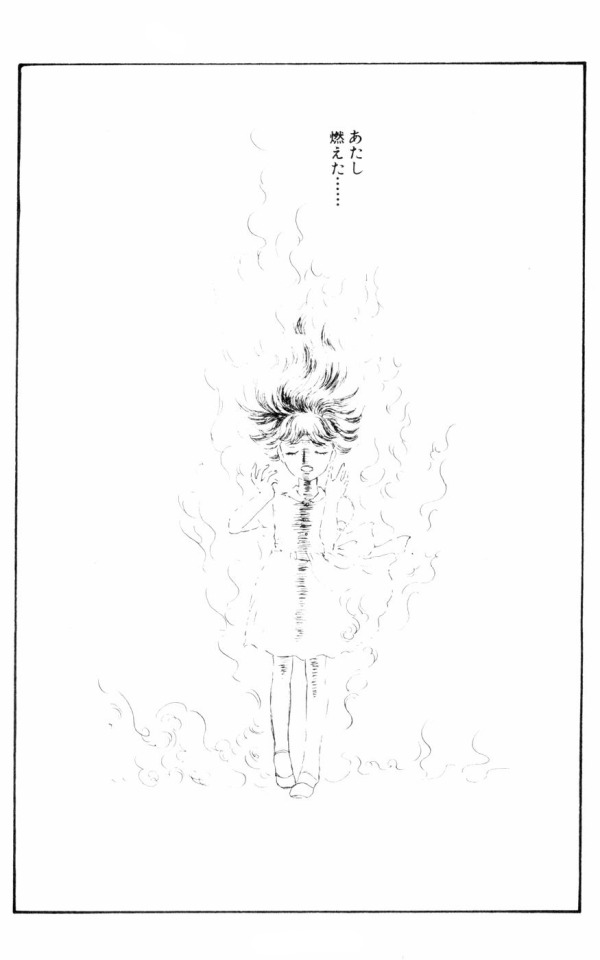
It is also in one tiny panel, but there is a guy criticizing the younger generation for being "apolitical" in this manga (see: しらけ世代), which I found interesting. Is Yamagishi condoning people who belong to that generation? Does she criticize the youth dor being apolitical and not caring about their country? Or is she trying to show that despite appearances, they care in their own way? As I'm not Japanese and I wasn't even alive in 1976, I lack the proper background to make a sound assessment on that. But still, it made me aware such concerns also existed in Japan. Isn't this the beauty of reading older manga? They make you think about stuff you'd normally wouldn't think about with a single bubble.
I canot stress it enough, but seeing what Nazım's poem made Yamagishi feel was a very unexpected yet great experience for me. This one shot will hold a special place in my heart.
#yamagishi ryouko#ryouko yamagishi#山岸 凉子#24年組#year 24 group#70s shojo#70s manga#vintage shoujo#retro shoujo#retro manga#vintage manga#nazım hikmet#夏の寓話#hiroshima#natsu no guuwa#summer fable#poetry#turkish poetry
32 notes
·
View notes
Photo
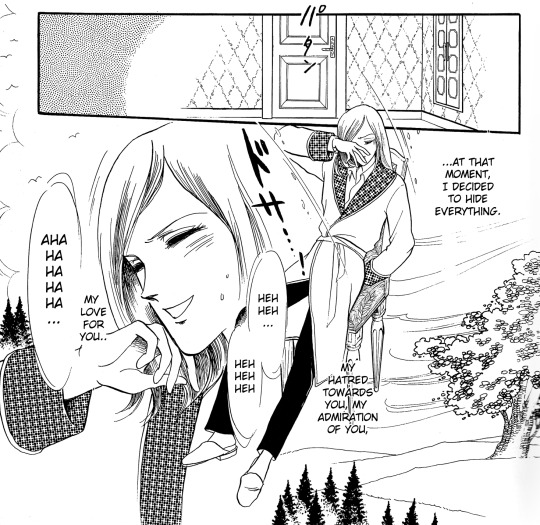

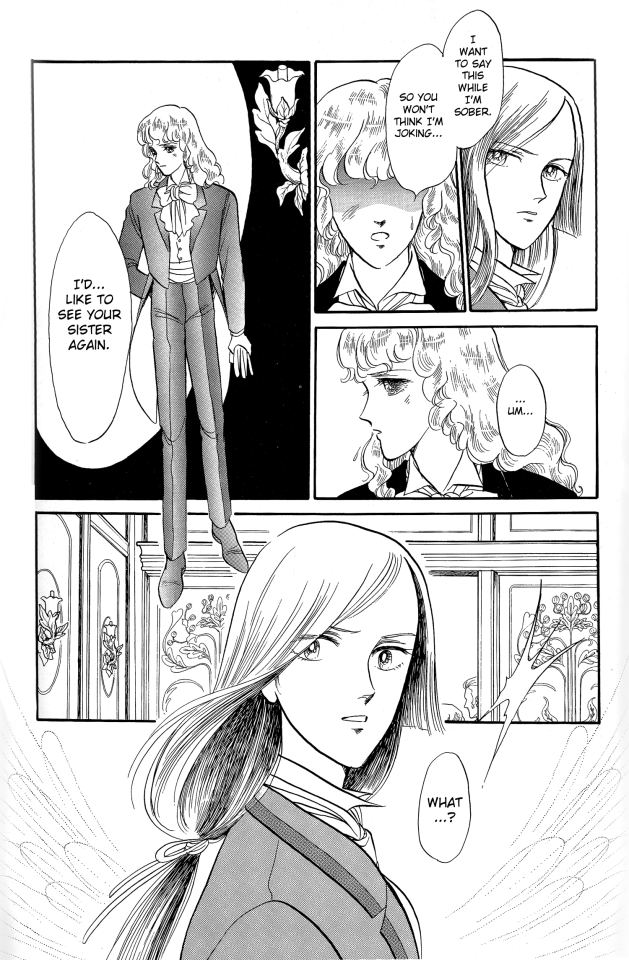
I can’t deal with the fact that these two dumbasses married women because of the similarities they had with each other pfff
#kazetokinouta#kaze ki#kaze to ki no uta#Kazeki#kaze#la balada del viento y los arboles#la balada del viento y los árboles#la balada del viento y los ?rboles#the poem of the wind and the trees#the poem of the wind and trees#the poem of wind and trees#takemiya keiko#Keiko Takemiya#le po?me du vent et des arbres#le poeme du vent et les arbres#le poème du vent et des arbres#jules de ferrier#julesxrosemarine#jules#rosemarinexjules#julesdeferrier#Rosemarine#arion rosemariné#Rosemariné Arion#arion rosemarine
58 notes
·
View notes
Text
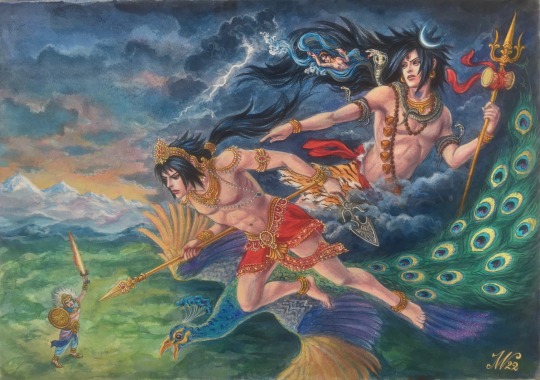
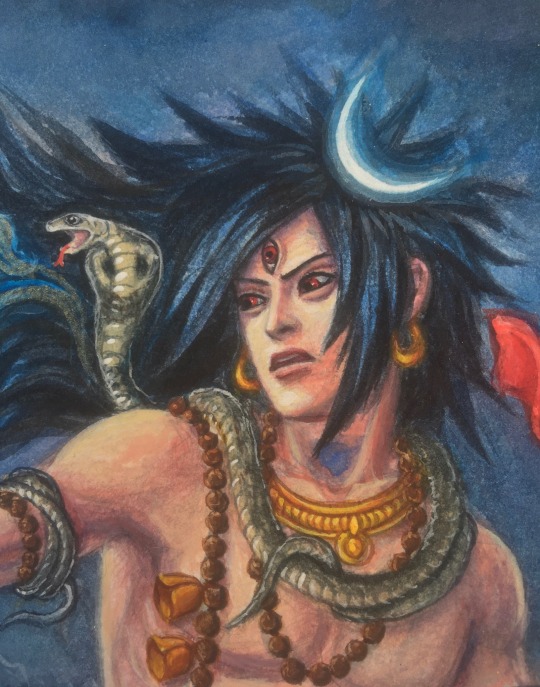
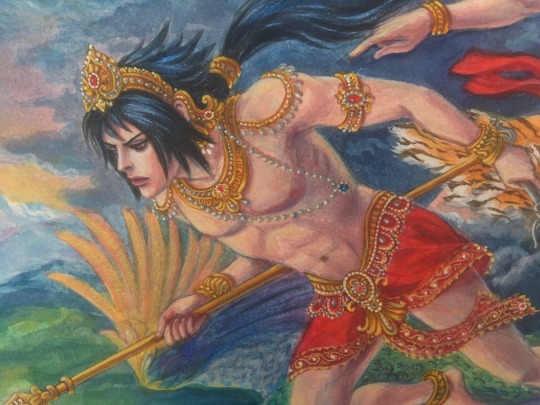
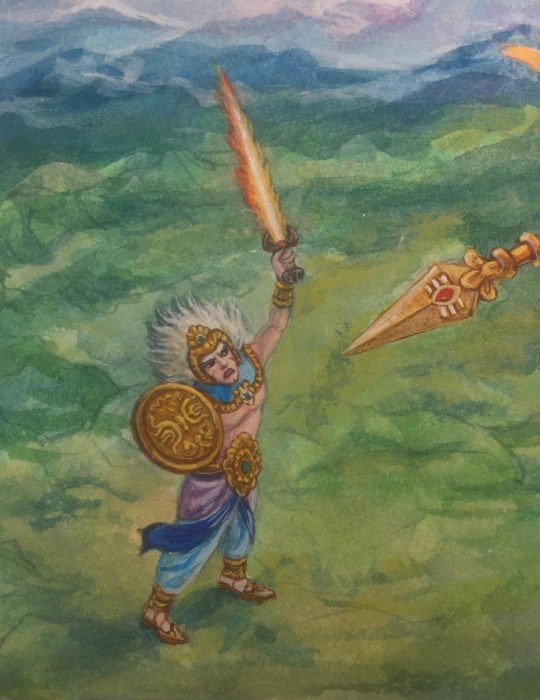
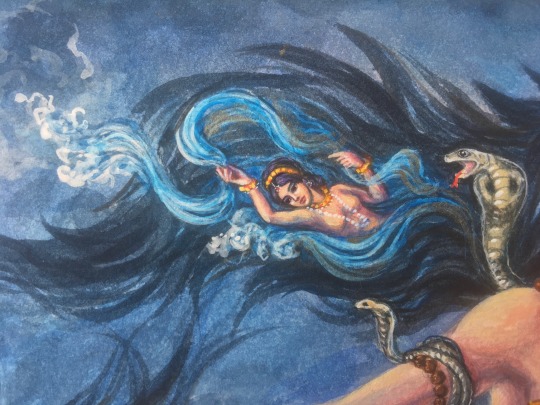
A modest gift for Madara’s Birthday.
Unfortunately right now I am incapable to paint something special so I post simply my illustration for @naruto-mythology-zine
Madara and Izuna are Hindou gods, fighting against Tobirama-ashura.
Paper, watercolour, acrylic and iridiscent pigments, 46x32 cm.
Special thanks to @officerjennie for her wonderful fic about this picture and to @writhingbeneathyou who made this brilliant project possible!
310 notes
·
View notes
Text
YEAR 24 GROUP
A group of women who revolutionized the world of shōjo manga and the vision of the female mangaka.
They are known as the Year 24 Group or as Forty-Niners since they were all born around the year 24 of the Shōwa era (1949)
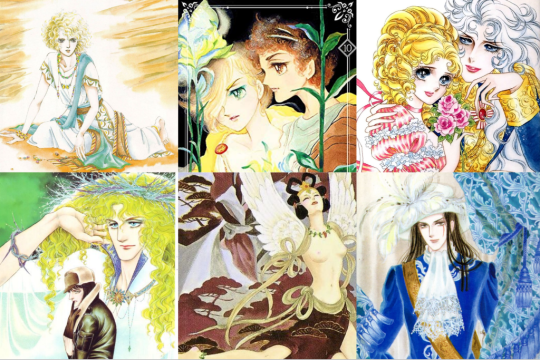
The entrance of women to the dedication of manga as a profession was very slow, since until then being a mangaka was a well-accepted job only for men. Meanwhile, Japanese women were still tied to housework.
But Japan after losing World War II was occupied for 7 years by the United States, which caused changes in Japanese customs. Beate Sirota, an American defender of women's rights, introduced legal equality between men and women in the 1947 constitution. She also gave the right to marriage by mutual agreement and lastly she gave women the right to divorce, to own/buy property and to inherit. Thanks to Sirota, women were freed little by little from being housewives, if they wanted, and were able to dedicate themselves to jobs that were previously considered for men, more naturally.
During the 70s, after the student strikes, the scourge of modernity and the sexual revolution, the mangakas of the Year 24 Group began to debut and the manga stopped having molds.
The Magnificent Forty-Niners cast aside the innocence of the female mangaka that preceded them, yet are aware of their limitations, praise their achievements, and serve as an influence.
The women of the Year 24 Group were by no means conformists, as evidenced in their works and private lives, and made shōjo an exploratory category in which they included new genres that had never been touched before in this demographic. Until now, Shōjo was mainly (if not only) about the simple life of high school girls, it was just about the slice of life. But these ladies gave depth to the characters, filling them with philosophical or existential questions and on several occasions the girls stopped having the leading role. They introduced other genres such as science fiction, shōnen-ai (currently bl, love between two men) or bildungsroman and included elements such as the exploration of sexuality, genderqueer characters, adult women, vampires or rock and roll. And they dared to place their stories in places outside of Japan and in the past.
Moto Hagio was the core of the Year 24 Group and shared an apartment outside of Tokyo with another top Forty-Niner, Keiko Takemiya, for 3 years (1970-1973). Later the apartment became the Ōisumigakuen or Ōizumi Salon, a center where beginner mangaka girls will go to learn about manga, help each other and share ideas.
Gradually they gained popularity. Moto Hagio, Keiko Takemiya, Riyoko Ikeda, Yasuko Aoike, Toshie Kihara, Minori Kimura, Yumiko Oshima, Nanae Sasaya and Ryoko Yamagishi, all of them are part of the Year 24 Group whether they are more or less known in the West, in Japan they won their recognition.
— MŌTO HAGIO (1949-)
Currently she is the best known of the "Year 24 Group". Although she liked to draw since she was a child and in adolescence she was clear that she wanted to dedicate herself to manga, she did not have it easy since her mother didn't like it.
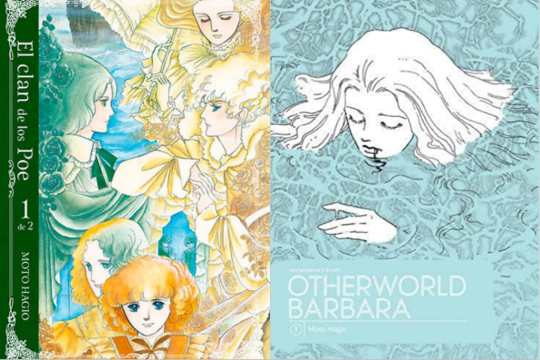
♡ The Poe Clan (1972-1976)
- Shōjo/josei (fantasy, horror)
- Spanish
♡ Otherworld Barbara (2002-2005)
- Josei (science fiction)
- English
—KEIKO TAKEMIYA (1950-)
Is dedicated to the teaching and dissemination of manga and also to preserve and reproduce manga with historical value.
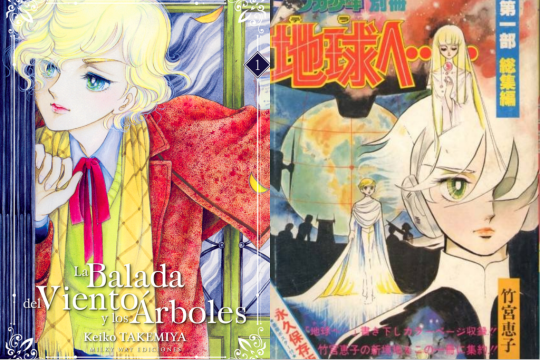
♡ The Song of Wind and Trees (1976-84)
- Shōjo (shōnen-ai/bl)
- Spanish
♡ Tera e... (1977-1980)
- Shōnen (space opera)
- Spanish
—RIYOKO IKEDA ♡ (1947-)
♡ The Rose of Versailles (1972-1973)
Studied philosophy at university while drawing manga, although she finally had to leave his studies due to pressure.
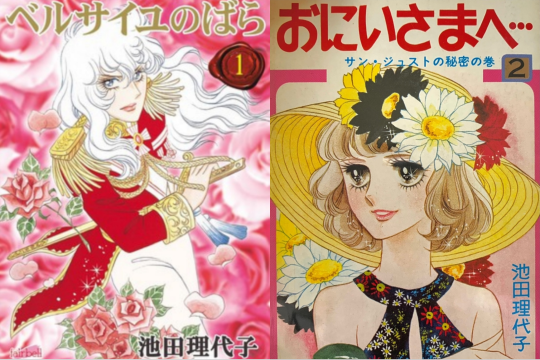
- Shōjo (historical, romance)
- Spanish / english
♡ Oniisama e... (1973-1975)
- Shōjo (drama, slice of life)
—YASUKO AOIKE (1948-)
Debuted at the age of 15 by winning an award from a magazine. The vast majority of her works are or have shōnen-ai elements, since she grew up surrounded by strong men (her family had a construction company).
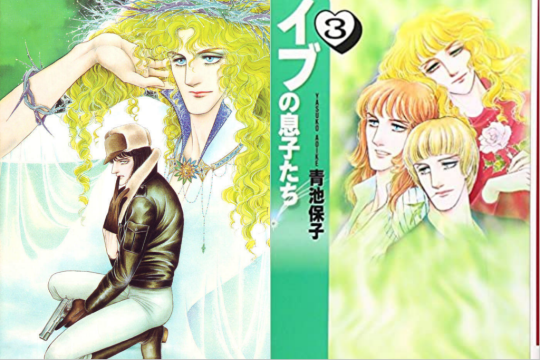
♡ From Eroica with Love (1976-2012)
- Shōjo (comedy, action, bl)
♡ Sons of Eve (1976-1979)
-shōjo (comedy, bl)
—RYOKO YAMAGISHI (1947-)
As a child practiced ballet, an element that is part of many of her works. And she introduced yuri as a genre in shōjo.
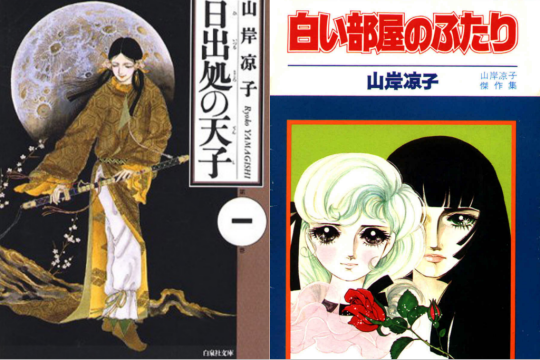
♡ Hi Izuru Tokoro no tenshi (1980-84)
- Shōjo (supernatural, historical)
♡ Shiroi Heya no Futari (1971)
- Shōjo (yuri)
—TOSHIE KIHARA (1948-)
The vast majority of her works are considered Josei, because they are not fanciful or humorous (there are exceptions). Some of her mangas have served as inspiration for musicals performed by the all-female Takarazuka Revue.
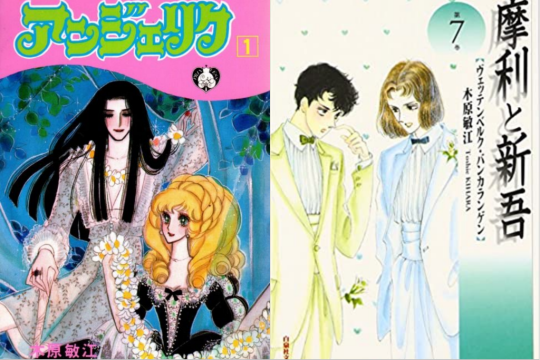
♡ Angelique (1977-1979)
- Shōjo (romance, historical)
♡ Mari to Shingo (1979-1984)
-Shōjo (bl, historical)
—NANAE SASAYA (1950-)
She is the youngest of four siblings. Her father wanted all his children to go to university and become teachers, but she gave it up to dedicate herself to manga. Is known for her horror stories with occult themes.
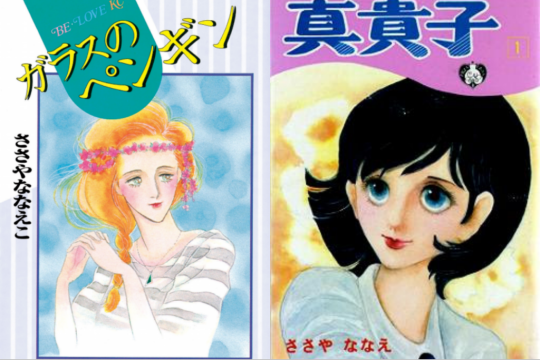
♡ Glass no penguin (1983)
- Josei ( Drama Slice of life)
♡ Makiko (1976)
- Shōjo (romantic comedy)
—YUMIKO OSHIMA (1947-)
Implanted new ways of making manga. Likes characters' thoughts being free on the page instead of in speech bubbles.
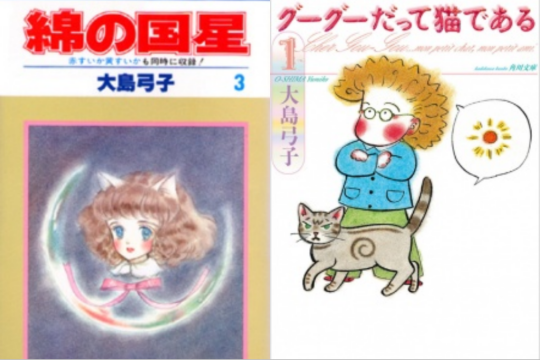
♡ Wata no Kuni Hoshi (1978-1987)
- Shōjo (fantasy, Romance)
♡ Gou Gou Datte Neko de Aru(1996-2011)
- josei (slice of life)
—MINORI KIMURA (1949-)
She debuted professionally at the age of 14 and, despite her very little recognition in the West, she is considered one of the brightest members of the "Year 24 Group". Some of her works are educational and deal with health issues.
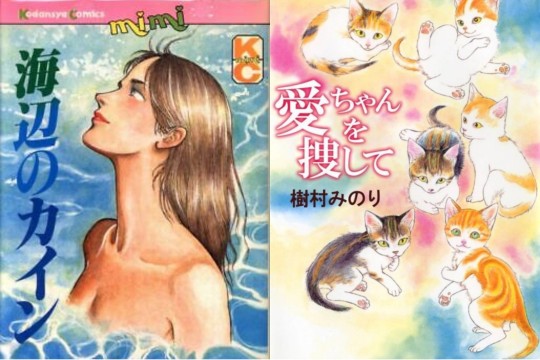
♡ Umibe no Cain (1980-1981)
-shōjo (yuri)
♡ Ai-chan wo sagashite (2011)
- shōjo (slice of life)
The effort of each of them was not in vain. The women of the Year 24 Group have achieved great awards and recognition over the years. They were nominated for 10 years in a row for one of the most prestigious Science Fiction awards in Japan, the Seiun Awards, and won up to 6 times (1978 y 1988). Moto Hagio won the Seiun Award in 1980, 1983 and 1985. They have also been awarded another of the most prestigious awards, but this time it is for manga, the Osamu Tezuka Cultural Award. Moto Hagio was the first person to receive the Osamu Tekuza Award for Excellence (1997). Some years later Ryoko Yamagishi and Keiko Takemiya also won it.
The Forty-Niners were the main and most relevant mangaka, but it doesn't mean that other female mangaka didn't arise during that time. Perhaps they didn't have such a revolutionary ideology or innovative way of making manga as the women of the Year 24 Group, but they also contributed to the world of manga (like Sumika Yamamoto with her manga Ace wo Nerae!)
The mark that these mangakas have left and continue to leave is not small at all. They have reinvented, innovated and set aside the limits. They made great strides despite having many things against them and thanks to all that, their works are classics today and all of them influence many current artists.
177 notes
·
View notes
Photo




Feb Fall & Fashion - Sol Bianca 1991
247 notes
·
View notes
Text
Indian are considered ugly in their own land, indian girl with indian feature get huge discrimination.
Answer to Why doesn't the Indian government spread Tamil culture all over India instead of dead Indo-Aryan and Arab cultures? by Anonymous https://www.quora.com/Why-doesnt-the-Indian-government-spread-Tamil-culture-all-over-India-instead-of-dead-Indo-Aryan-and-Arab-cultures/answers/34953528?ch=15&oid=34953528&share=9a03de43&target_type=answer
#indian#india#brown people#racisim#natural selection#sexual selection#beauty of indian women#indian women#caucasian#european#bollywood#white obsession
0 notes
Text
Senju's Family Crest: Deeper meaning
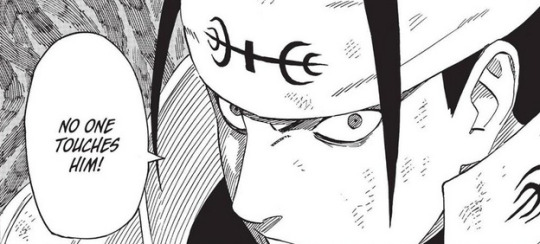
金剛杵kongousho/vajra, an important buddhist symbol. 金剛 is hardest material, diamond, indestructible.
Indra, his rivals, Asura, and his weapon Vajra
Indra/Asura/Vajra are a bit different in Hinduism vs jp, mainly esoteric, Buddhism... So i want to learn, write, discuss.
Obviously, Religions, esp Hinduism, very diverse(diff groups/sects/regions say diff things, across diff time periods), this is general/simplified idea. if want correct/add.
Hinduism
Indra, said to be "title", rather than "name", king of Svarga, king of devas, associated with rain/storms. Known to wield Vajra, unstoppable, indestructible thunderbolt to vanquish evil spirits/sinners. A legend says that Indra has 1000 eyes, which used to be ?????? which he was cursed with due to his lust for women.
A legend says that Indra's Vajra originated a spinal column of Sage Dhadhichi, bones blessed by Lord Shiva earlier, who offered it, sacrificing himself, to help Indra defeat a powerful asura, Vritra.
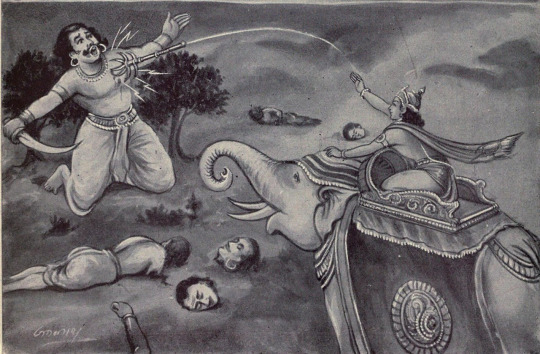
Devas are rivals of Asuras, which are sometimes demonlike, power hungry, associated with drought/famine. Indra killing Vritra symbolizes drought/rain cycle.

Param Vir Chakra, designed by Savitribai Khanolkar, India's highest military medal has Indra's Vajra, symbolizing Sage Dhadhichi's great, selfless sacrifice.
Random: In Hindi indradhanush-> Indra's bow, rainbow. eng/hindi, look/sound different but think similar. rain, indra(rain/storms god) + bow(weapon) =rainbow.
indo-european heritage? There's also many other languages of India. I wonder how common "rain/god+ bow" is?
jp/chinese, 虹niji/rainbow = 虫/creature + 工/strike because think as living dragon/snake which ran through the sky. So 虹"male" and 蜺/霓"female" rainbows, top/dimmer one in double rainbow. Unsure about the kunyomi(native japanese pronunciation, not chinese) origin though.
Japanese Buddhism
三十三間堂sanjuusangendo/33 forms hall, in Kyoto, has famous 28 group of statues/gods who are protectors of main idol, SenjuKannon considered servants/protectors of Buddhist Teachings. link. 大梵天Oobonten/Brahman, In Hinduism more like concept of ultimate reality, existence, but In Buddhism more like god said to spread the teachings of Buddhism. 帝釈天Taishakuten, King of Tendou/Deva realm, and 天部tenbu/devas race. often seen next to Oobonten. Center/commander of the 四天王/4 heavenly kings, who monitor/judge humans. Connected to warding evil, healing illness. 阿修羅王Ashuraou, King of Shuradou/Asura realm, and Ashuras race, sometimes rivals to Tenbu. In some interpretations seen as a sun god. in particular, main purpose is "protection of Buddhist teachings".
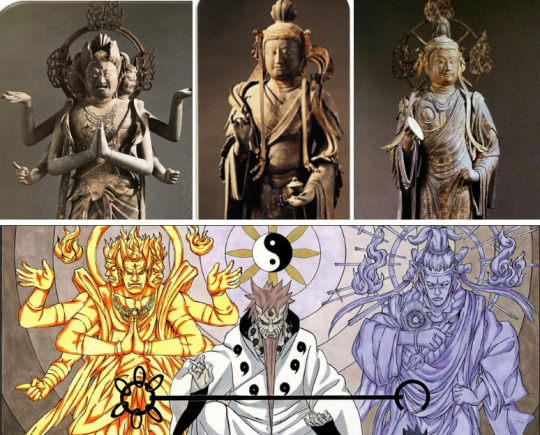
六道rikudou/6 paths of reincarnation, are said to be tendou, ningendou/human, shuradou, chikushoudou/animal, gakidou/hungry spirit, jigokudou/naraka, hell. They live/die/reborn.
外道gedo(in relation to rikudou)/outer path, is outside the circle of reincarnation, such as tengudou, because tengu(former monk died with pride) knows buddhist teachings, can't reincarnate as a human, but is immortal as a tengu so can't continue. 解脱gedasu/moksha, enlightment, is another example.
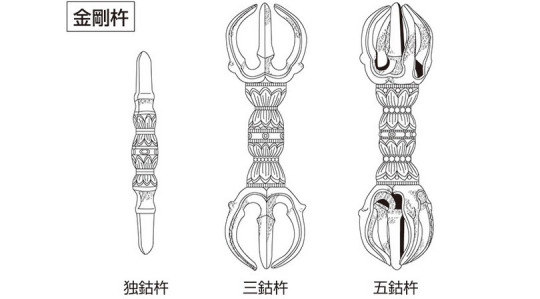
五鈷杵gokusho is type of Kongosho has four prongs pointed to center one. One side said to represent 5 buddhas, 5 wisdoms, while the other 5 greeds to mean indestructible truth of Buddhism. (Butsuma + 4 children adds up to 5?)
A legend says Vajra had multiple prongs pointed outward to showing it's use as a weapon to harm. However, Buddha desires end suffering/harm for all , so he took and pushed prongs inward to turn weapon into an equally powerful tool for self improvement, destroying inner desires, greeds, etc.

In Naruto
Shintou Kami sometimes seen as manifestations of Buddhas/Tenbu(本地垂迹), so I think it fits to see OotsutsukiIndra's Uchiha use Kami(Amaterasu, etc) from creation story as the name of their doujutsu.
Senju's family crest is a vajra with inward prongs, in a sense, a former unstoppable/indestructible weapon of Indra turned into a peaceful staff -> A symbol of OotsutsukiAsura's desire or prophecy to change OotsutsukiIndra.
Hashirama not wearing Senju headband, is kind of like giving up changing Madara. Or changing priorities, gokusho(desires to change OotsutsukiIndra) -> leaf(village protection).
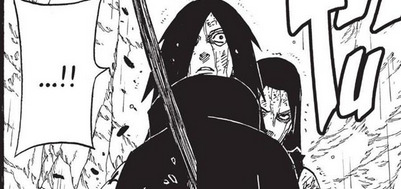
But there's one that does not give up.
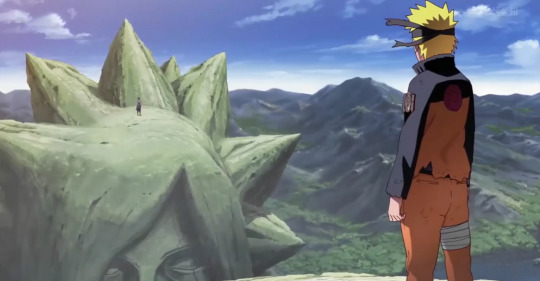
246 notes
·
View notes
Text
Translated Kaze to Ki no Uta Doujinshi

Hi there! Finally, I translated something that at least 5 people would actually be interested in. For those of you on twitter, the art of user @Quartzcastle88 ( 水城晶) may have come to your attention. They primarily draw fanart and doujinshi for Kaze to Ki no Uta, all of which are astoundingly adorable with a distinctly retro sensibility. With their permission, I have translated three of their doujin.
The first, and shortest of the bunch centers around Rosemarine and Jules. The other two are very fluffy snippets of Gilbert and Serge’s school life. I hope you enjoy them as much as I did!
You can download the doujins here.
152 notes
·
View notes
Photo

Princess learning archery, Gopal Charan Kanungo.
Click for larger image to see ladies with bow and arrows/spears:)
Let a Thousand Flowers Bloom: Contemporary Art of Orissa
#princess#indian princess#archery#women archers#odia art#I will take it that this is Kalinga#Gopal Charan Kanungo#indian art#ancient world in art#ancient india
126 notes
·
View notes
Photo
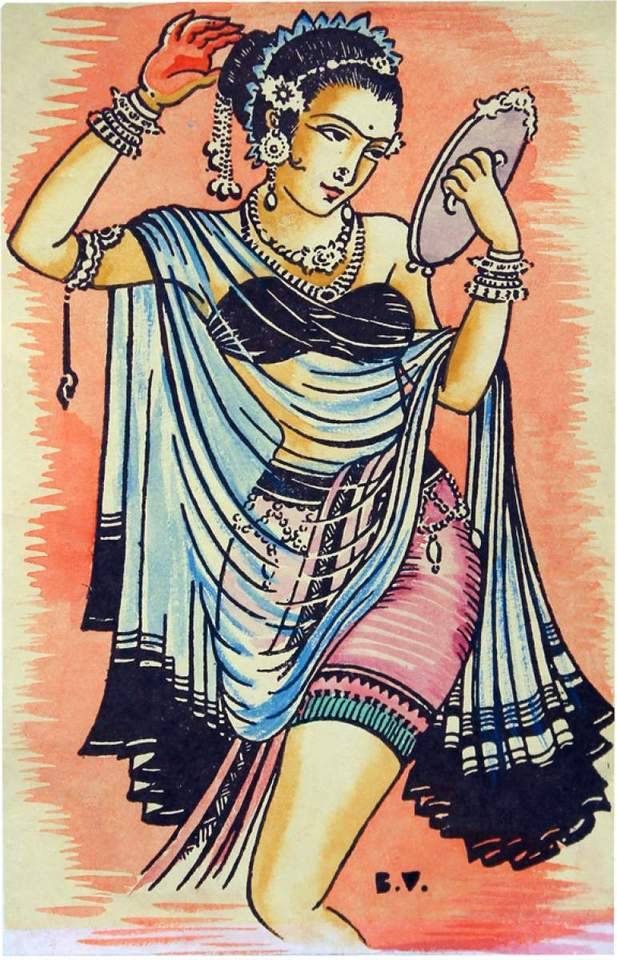
Of course it is impossible in cold countries to display the beauty of ornaments, which have to be worn on the bare body, for if they did so they would suffer severely from cold. So the fondness for ornaments is transferred to, and is satisfied by, the niceties of dress. As in India the fashions in ornaments change very often, so in the West the fashions in dress change every moment. Civilisation and Dress, Swami Vivekananda: Complete Works.
Vivekananda’s perspective on the Indian use of jewellery and how it has multiple meanings regarding style, status and the like.
Today is Yuva Diwas/National Youth Day.
The artwork is Palli Badhu (Village Bride) - described as a watercolour on silk, in the wash style that features a bride with embellishments against a lightly coloured sari - by the Odia painter Bimbadhar Varma. Via IPCA.
#swami vivekananda#national youth day#indian art#vintage art#village bride#indian jewellery#odia art#uttariya antariya#indian costume#bimbadhar varma
195 notes
·
View notes
Photo




Jubei Chan 2 DVD Art Covers (2004)
#Jubei Chan#Jubei Chan 2#Jiyu Nanohana#Nanohana Jiyu#Ayunosuke Odago#Odago Ayunosuke#Freesia Yagyu#Yagyu Freesia#Furo Kita#Kita Furo#Jubei Chan the Ninja Girl 2#Jubei Chan edit
132 notes
·
View notes
Photo
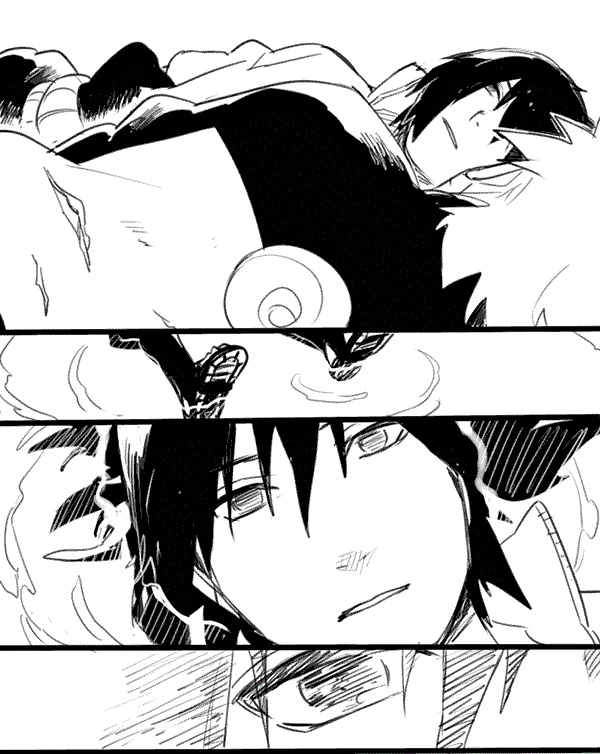

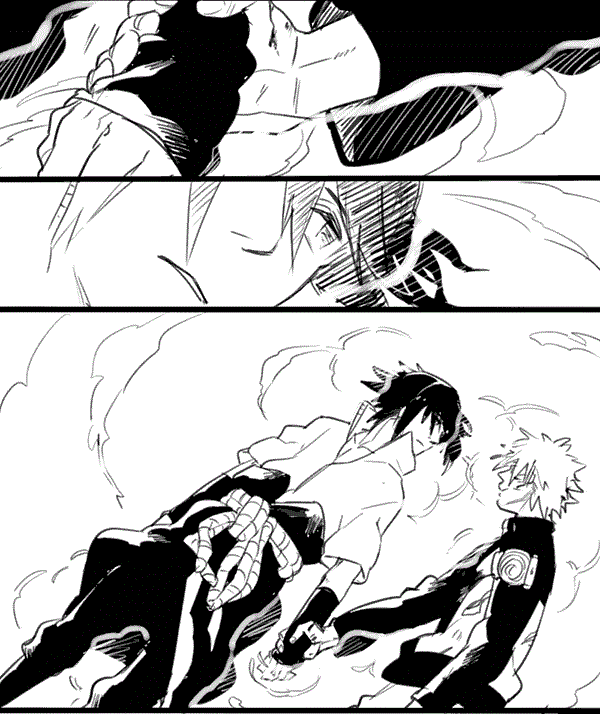
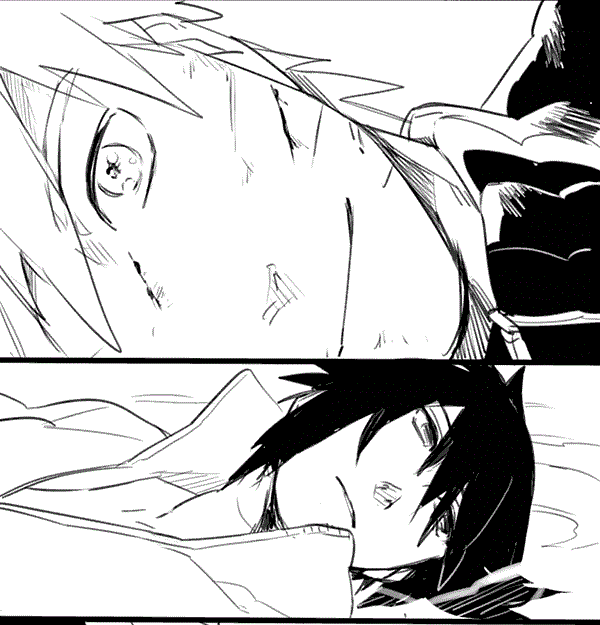
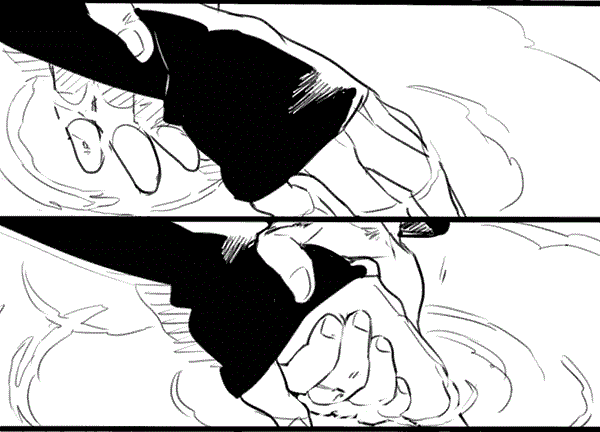
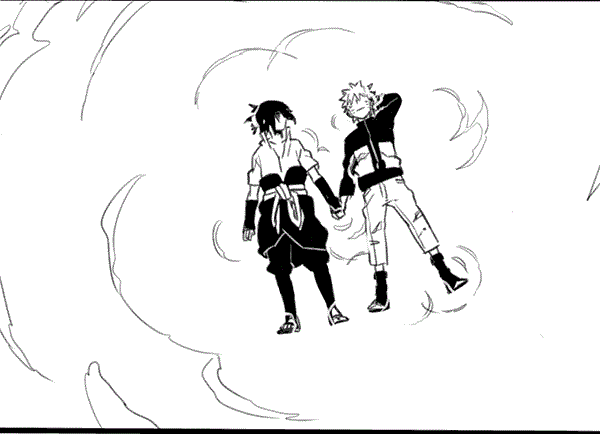
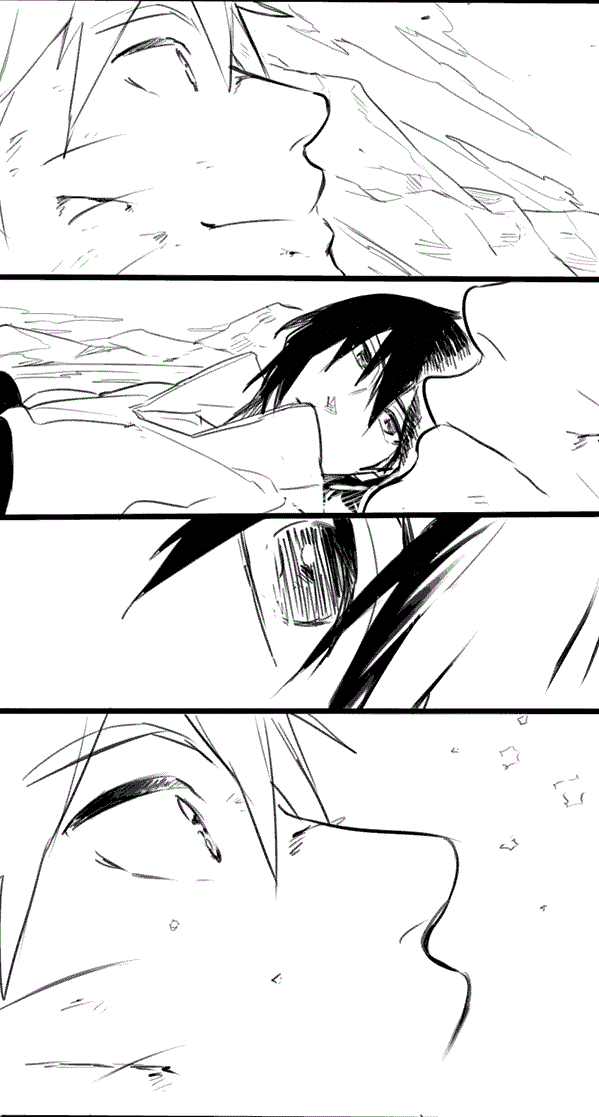
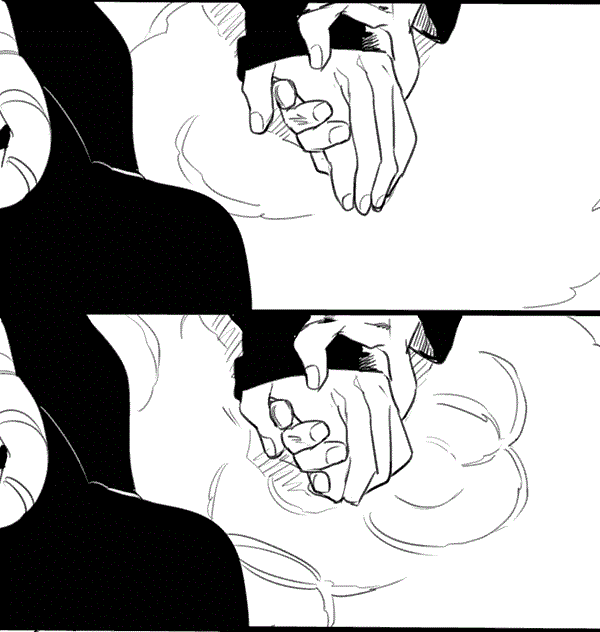


By your side by i
#naruto#Naruto Uzumaki#Sasuke Uchiha#narusasu#translated#translated comic#in better times#when sasuke wasnt such an a-hole#still hate the dude#wish their lives were so much easier
8K notes
·
View notes
Text
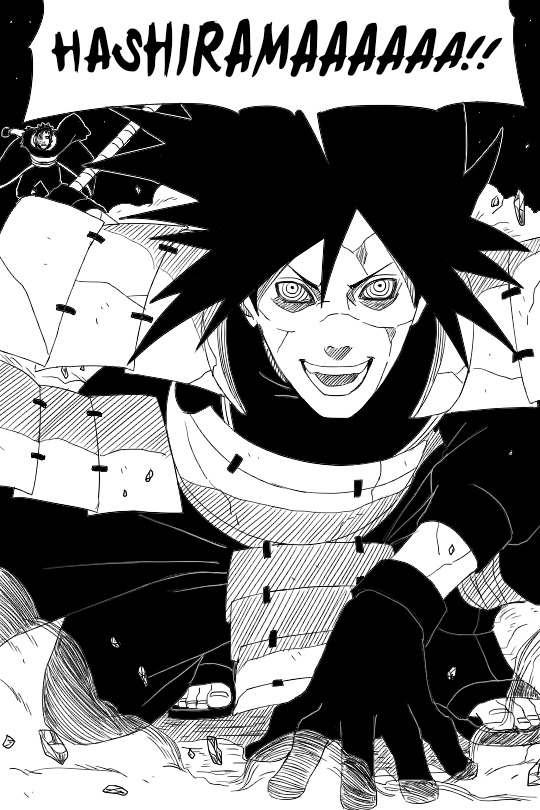

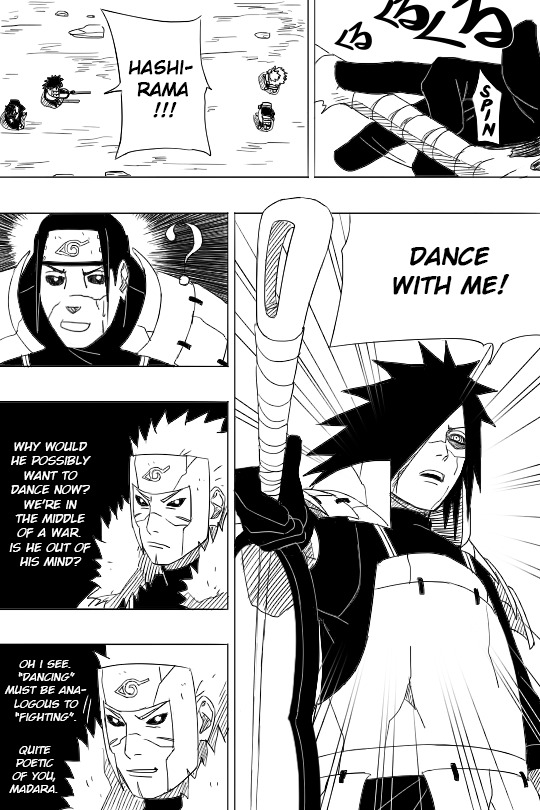

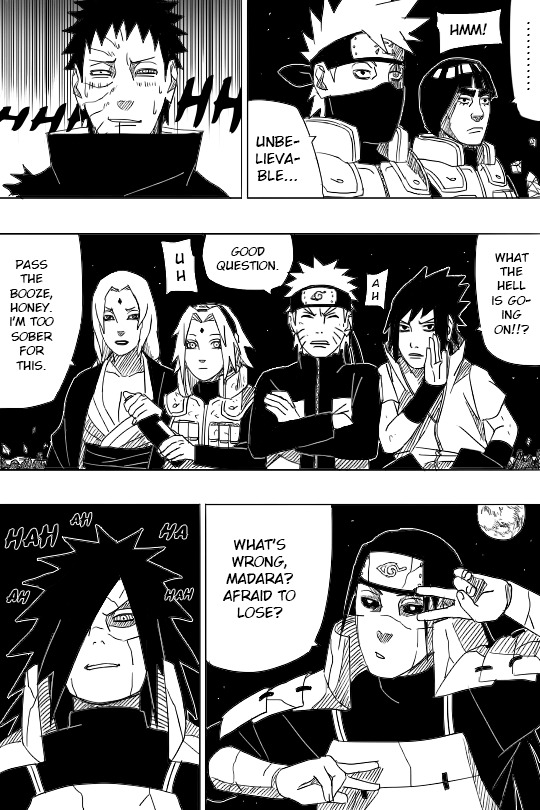

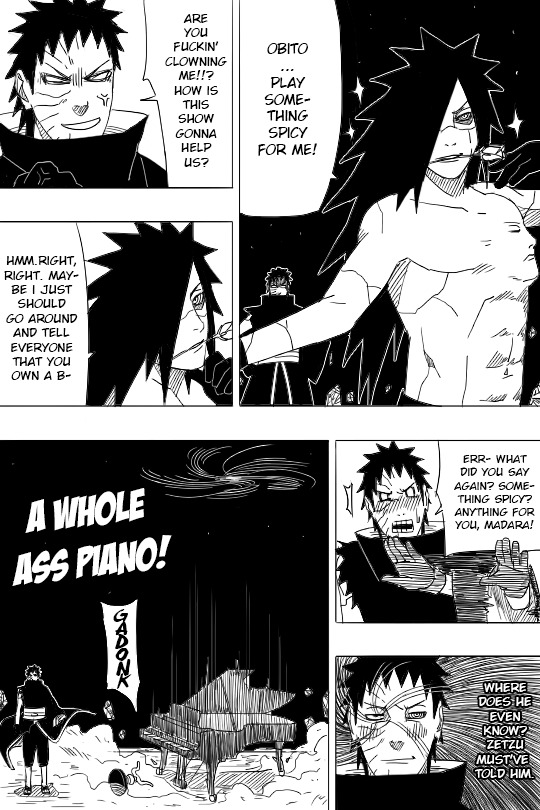

cha cha real smooth
11K notes
·
View notes


